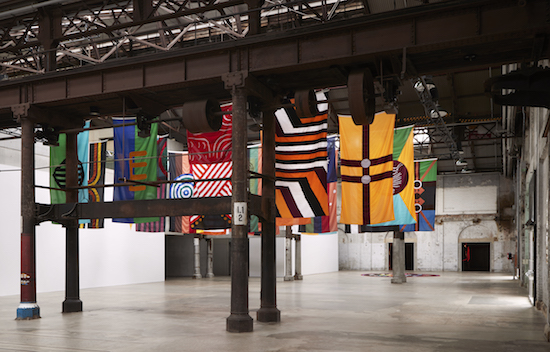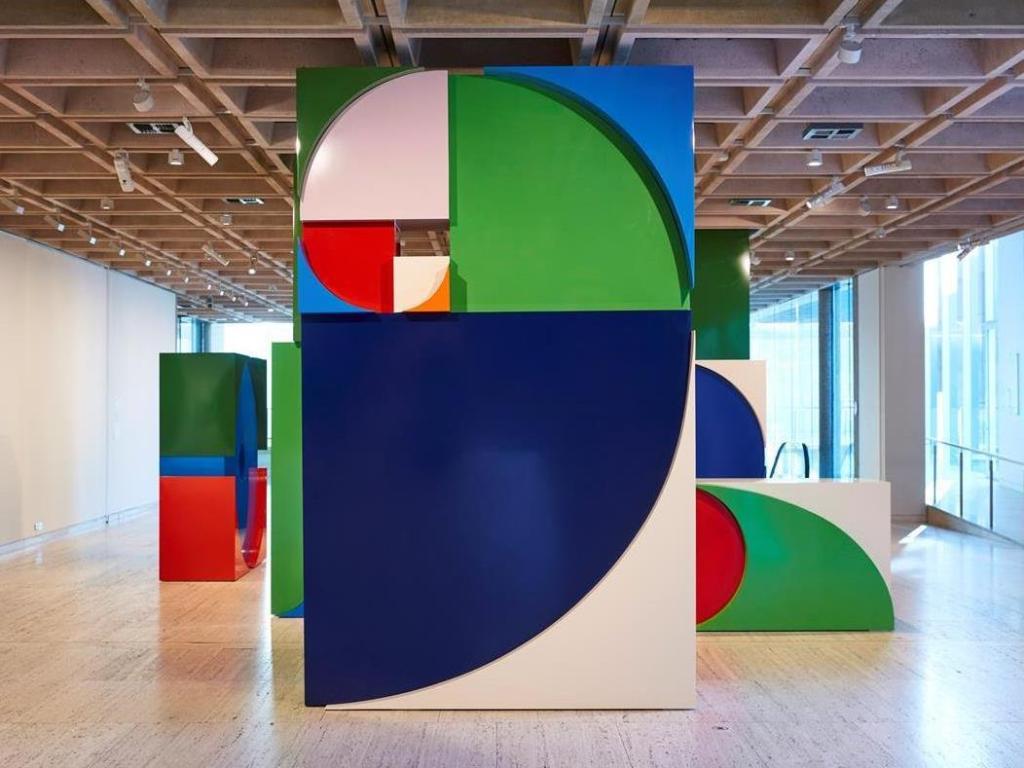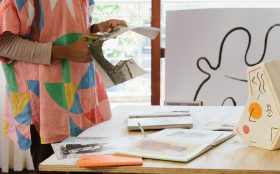Emily Floyd’s Kesh alphabet 2017 installed at AGNSW for The National; courtesy Art Gallery of New South Wales, Atelier and Contemporary Collection Benefactors 2016 © Emily Floyd.
A question on many lips in the art world is ‘Why? Why do we need The National?’
This weekend, The National 2017: New Australian Art will be unveiled to the public, featuring works by 48 artists touted as ‘the latest ideas and forms in contemporary Australian art’.
It is presented jointly by the Art Gallery of NSW (AGNSW), Carriageworks, and the Museum of Contemporary Art Australia (MCA), and is the first-ever curatorial collaboration between these Sydney majors. The plan is to continue the momentum of the Biennale of Sydney in its off years.
Co-curator Blair French (MCA) told Artshub: ‘We do not have a large scale survey of current Australian art practices anywhere in the country, and particularly one that considers audiences on the east coast.’
A formal statement extended that idea: ‘The exhibition offers a holistic view of Australian art at a point in time, and fosters dialogue between generations of artists.’
While that sounds terribly laudable, there are some bigger questions to be asked about this – dare we call it – blockbuster.
Agatha Gothe-Snape is one of a couple of artists shown across the three venues. You and everything that is not you (Art Gallery of New South Wales) 2017 lifts the words of critic Robert Hughes’ from his last episode of the iconic series “Shock of the New”; Courtesy the artist and The Commercial, Sydney, © Agatha Gothe-Snape
Putting The National in context
The National cannot be considered in isolation. The parallel that it poses with Australian Perspecta (1981-1999) is too large to deny.
Initiated by Bernice Murphy (who went on to be the inaugural Chief Curator of the MCA), Australian Perspecta was a biennale survey of current Australian art at the Art Gallery of New South Wales, and was held in the off years to the Biennale of Sydney (1973-ongoing). Sound familiar?
In 1997, it expanded from the Art Gallery to exhibit in a number of Sydney venues, including the Museum of Contemporary Art.
The final exhibition, Perspecta ‘99 (as it had been rebranded) took this pluralistic tendency to an extreme. It involved 15 curators and included 76 artists corralled under the theme Living Here Now – Art and Politics. It was described: ‘The breadth of its remit made the show feel more like a festival than a cogent curatorial project.’
That international critic continued: ‘Perspecta ‘99 follows in the path of many biennials, offering a large, quirky survey of contemporary practice rather than a purposeful statement. To its credit, the show attempted to develop discussion around issues that are timely, but when so many people are talking at once, the subject of conversation tends to get lost.’
Could we use those same words to describe this inaugural edition of The National?
Interestingly, the co-curators of The National, Wayne Tunnicliffe and Blair French, were involved in that last Perspecta curatorium, and some artists such as Justene Williams, Gordon Bennett, Karla Dickens and Khaled Sabsabi also draw a connecting thread across that 18-year hiatus.
The big question remains why, in 1999, the value of surveying Australian art was deemed no longer necessary. Was the audience-to-cost equation just not working? Had our interests gone offshore, or had that responsibility to show living Australian artists become more shared and embedded in programming across many institutions of differing scale?
Equally importantly, why revive the model now?

Alex Gawronski connects the three venues with architectural interventions. Threshold from the series Ghosts 2017 takes its cue from Carriageworks here at the AGNSW; Courtesy the artist © Alex Gawronski
Shifting focus
The late 1990s were an interesting time in Australia, and in particular Sydney. The MCA had opened in late 1991, and with nearly a decade under the belt by the time Perspecta concluded, the Museum had shaken off opening problems of financing with a move from the University of Sydney and the Power Bequest as key stakeholders, to the NSW Government, in 2001. It had become a strong contemporary voice.
The Adelaide Biennale of Australian Art was established in 1990 – equally as important as Perspecta in this national dialogue – and today remains the country’s longest-standing survey of contemporary Australian Art. The MCA initiated Primavera in 1992, today an ongoing exhibition that surveys artists under 35 years, as well as the series, Focus on Contemporary Australian Art, which ran for several years, wrapping in 2003.
I’m going to argue that the ensuing two decades after Perspecta ‘99 our collective curatorial focus got caught in a lens directed towards emerging talent. We started to see funding, prizes and exhibitions swell around the phenomenon of the “hot young artist”, fueled by an art market tapping into international trends. It was more focused on rising individual stars rather than their place in a broader context.
At the same time, as parochialism lessened with the decline of the tyranny of distance, the flavor was to be either young or peripatetic. We had all but forgotten what Perspecta stood for.
There is another factor that could be argued as contributing to The National, and that is the revival of a cross-generational examination of what was coming out of Australian studios.
Melbourne Now was staged by the National Gallery of Victoria in 2014, and Sydney Contemporary had its inaugural event in 2013. While coming from two very different positions, both were huge successes with audiences, Melbourne Now drawing crowds of 753,000 visitors and the new art fair 32,000 over four days, generating $10 million in sales.
Even mid-tier institutions like Melbourne’s Australian Centre of Contemporary Art (ACCA) were picking up on those successes, turning to large-scale surveys of artists working now with the likes of the Painting. More Painting show (2016).
This zeitgeist affirmed that the contemporary art survey did have a place, and perhaps also allowed the argument, within the chambers of major institutions, that such shows had the capacity to engage audiences – including new audiences – just as much as the buy-in Rubens or Hermitage blockbuster.
But why did we need to badge The National within the biennale framework when individual institutions were consciously turning to programming cross-generational surveys?
Zanny Beg The City of Ladies (video still) 2017, directed with Elise McLeod and showing at the MCA; courtesy the artist
Home grown commands big dollars
The in-house blockbuster seemed to be the new future. Queensland Art Gallery I Gallery of Modern Art (QAGOMA) has defined its territory with the Asia Pacific Triennale (1993 – ongoing); the National Gallery of Australia (NGA) started the National Indigenous Art Triennial in 2007 (ongoing); and the National Gallery of Victoria will present its inaugural NGV Triennial in December this year.
Like the Biennale of Sydney, the NGV Triennial will place Australian artists within an international context but also extends its charter to design, animation and new technologies – building on the success of Melbourne Now.
In an interview with The Sydney Morning Herald in 2014, when the idea of the Triennial was announced, NGV said they expected it to cost $8 million to stage.
My guessing is that The National’s bottom dollar is nowhere near that price tag.
Tunnicliffe told ArtsHub that The National had very strong support from sponsors, allowing artists to be paid a fee along with the full production of their work and assistants. The exhibition will also be delivered free. He also made the point that a large number of the artworks presented at the AGNSW have been, or are in the process, of being acquired, extending that measure of support.
If one was not a cynic, they might argue that The National fills a role in supporting living artists where funding cuts have failed them. But the flipside to that argument is that in a climate where small organisations have closed their doors and artists’ projects have been cancelled, those government streams of support might have been better directed to the primary source, rather than staging a multi-venue exhibition with the majors.
The reality – as it has always been with these big festival-style exhibitions and biennales – is that it is a familiar role call; and in this climate that is a blow harder to take on the chin.
The foundations of “why” still remain thin. Providing another platform for artists working now just feels like box ticking or calendar filling.
The National has been committed to until 2021 and will deliver three editions. Three editions is a short institutional commitment, and I fear that “the experiment will be done” and energies will be funneled towards the next good idea.
MCA Director Elizabeth Anne Macgregor did lift my hopes in her opening address for The National. She tipped her hat to DFAT and their International Curators Program that had ferried a junket of curators to Sydney for the exhibition.
While our embrace of the clichéd of distance may have shifted, as Australian artists and arts professionals we need to work much harder in shifting that perception abroad. Perhaps the scale and badging of an exhibition like The National allows that, which the one-off in-house curated survey shows lack in terms of international pull and weight.

Archie Moore’s Untitled Neytions (2014-2017) installation view Carriageworks; Image Zan Wimberley
…and the exhibition?
Stepping off that ever-so slippery soap box, and looking at the content rather than the context of The National, the big brand identities of these institutions do push through – the selection at the MCA has a decidedly MCA badge or feel, turning to time, process and gesture; Carriageworks similarly plays with its architecture and has a bent towards contemporary performance; the AGNSW is more calmly paced with less bold bling, looking at social, environmental and political histories.
That should be applauded, in that these institutions have really developed their points of difference and well recognised brands.
The reality sadly sits counter to their joint statement on working together ‘to produce a single exhibition that unfolds across the three sites’.
AGNSW Director, Michael Brand, explained the choice of three venues: ‘It is about making more space for artists – about more space for their work – and to show those three different institutional voices. You will see a different atmosphere at each venue.’
Making her art world debut, NSWs newly appointed Premier, Gladys Berejiklian, said at last night’s opening: ‘All have unique histories and are unique institutions … competition is a good thing but collaboration is even better, and that is something we are really encouraging.’
Is the framework of ‘partnership’ and ‘work now’ enough to hold an exhibition of this scale together?
The most cohesive venue is the AGNSW, by a long shot, and I feel they really extended themselves curatorially into a fresh space. Carriageworks in comparison feels congested for the work it is presenting, and the MCA – if we are talking generalisations – sits somewhere between the two. I am still jarred by the pairing of Gordon Hookey’s work critiquing Pauline Hanson’s One Nation sitting next to Nell’s work at the MCA.
Overall, the exhibition feels discombobulated. It’s like a smorgasbord where the cheese selection sits next to the carvery, and the desserts amidst the soup. There are lots of tasty morsels, but the plate filled after doing the rounds looks more like a dog’s breakfast.
But then that might be OK if this exhibition’s agenda is primarily about audiences. Tunnicliffe said that the organisations recognised that while they had overlaps their audiences had grown in different ways, and to cross-fertilise and aggregate those audiences was a further agenda for The National.
Berejiklian continued: ‘This project will no doubt make a contribution to our cultural event calendar over the next six years and [be] a major drawcard to our great city. Other States might try to disagree, but Sydney is well know to be Australia’s cultural capital,’ adding that she felt the groundswell would make this a permanent fixture.
A little like politics, bravado creates belief. The National, with its biennale formula, may ferry us into a new chapter for Australian artists and their deeper recognition – both at home and abroad.
The National 2017 has been curated by Anneke Jaspers and Wayne Tunnicliffe (AGNSW); Lisa Havilah and Nina Miall (Carriageworks); and Blair French (MCA). The exhibition is showing across the three venues from March – May.


_2017 (1) (HighRes).JPG)




